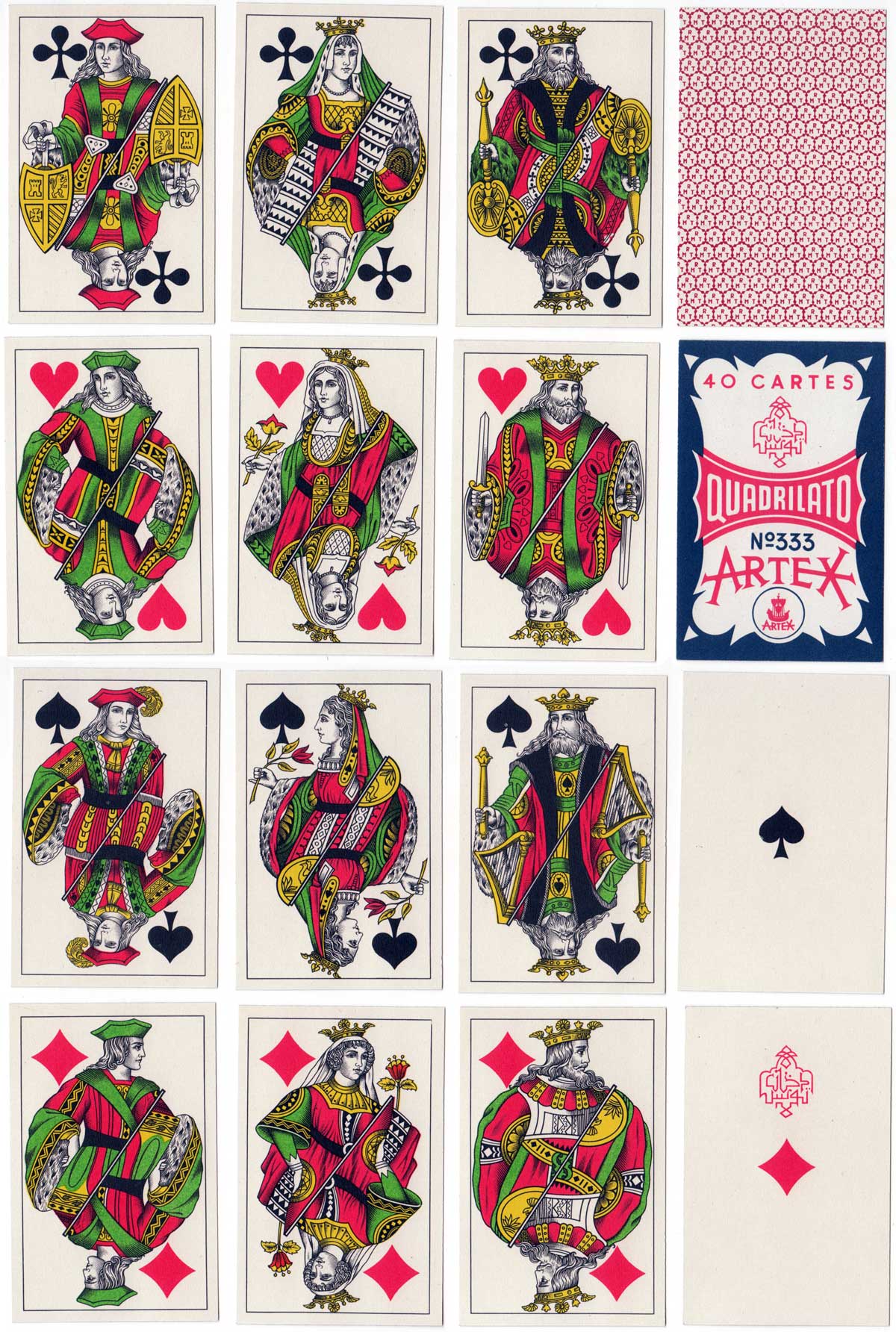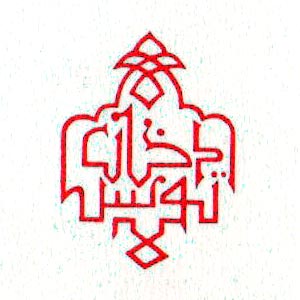Artex Quadrilato for Tunisia
Artex Quadrilato No.333 for Tunisia
Artex Quadrilato No.333 for Tunisia
Playing cards in Tunisia have followed French influence. These Belgian/Genoese type playing cards are based on the French Paris pattern produced by Grimaud in late 19th century, but with green replacing the usual blue. The Jack of Clubs has a triangular shield whose design resembles the coat of arms of the former Spanish Netherlands. Grimaud's pattern was used in casinos in Belgium, Spain & South America, and had also been extended into the Ottoman Empire, the Balkans and the Mediterranean from Algeria to Syria. It is also known in Turkey. It is gradually being replaced today by the Anglo-American pattern.

Above: Artex “Quadrilato No.333” Genoese style playing cards for Tunisia, 40 cards, square corners, c.1970. The Arabic imprint on the Ace of Diamonds refers to the Tunisian tobacco and playing card monopoly, while the letters 'RMT' on the backs signify 'Régie Monopole Tunisie'. “Artex” was the export brand name used by Játékkártyagyár és Nyomda (Playing-Card Factory and Printing House) after Piatnik pulled out of their Budapest branch. Images courtesy Rex Pitts.
See also: Genoese style playing cards for Tunisia by Léonard Biermans, c.1970→

By Rex Pitts (1940-2021)
Member since January 30, 2009
Rex's main interest was in card games, because, he said, they were cheap and easy to get hold of in his early days of collecting. He is well known for his extensive knowledge of Pepys games and his book is on the bookshelves of many.
His other interest was non-standard playing cards. He also had collections of sheet music, music CDs, models of London buses, London Transport timetables and maps and other objects that intrigued him.
Rex had a chequered career at school. He was expelled twice, on one occasion for smoking! Despite this he trained as a radio engineer and worked for the BBC in the World Service.
Later he moved into sales and worked for a firm that made all kinds of packaging, a job he enjoyed until his retirement. He became an expert on boxes and would always investigate those that held his cards. He could always recognize a box made for Pepys, which were the same as those of Alf Cooke’s Universal Playing Card Company, who printed the card games. This interest changed into an ability to make and mend boxes, which he did with great dexterity. He loved this kind of handicraft work.
His dexterity of hand and eye soon led to his making card games of his own design. He spent hours and hours carefully cutting them out and colouring them by hand.
Related Articles

An Anonymous Belgian Transformation Pack
Anonymous Belgian transformation pack borrowing many images from earlier designs by Braun & Schneide...

Blake et Mortimer – La Marque Jaune
Blake and Mortimer comic strip characters created by Edgar P. Jacobs.

Santo Mexico playing cards
Santo Mexico playing cards designed by Cédric Volon with Mexico-associated symbols.

Gallia Belgica playing cards
Gallia Belgica playing cards by Cédric Volon presenting a view of Belgian culture and folklore.

Historical Characters
Double-ended deck with historical characters and jacks as jesters by Daveluy, c.1850.

Mademoiselle Lenormand
XIX century ‘Mlle Lenormand’ cartomancy deck by Daveluy, Bruges.

Printing Presses
Antique printing presses from the Turnhout Playing Card Museum collection.

Le Roi bridge
Reprint of a Piatnik (Budapest) pack of 1927 with Hungarian historical figures and scenic aces.

Club Soft Drinks
Promotional pack for Club soft drinks with amusing illustrations of different kinds of ‘club’.

High School Musical 3: Senior Year
American teen film depicting students staging their last spring musical.

Postabank 3
Caricatures of German personalities on a promotional pack for a Hungarian commercial bank.

Postabank 1
Caricatures of Hungarian politicians on a promotional pack for a commercial bank.

Jeu Quatre Empereurs
Brazilian scenic aces with emperors of Brazil, Austria and France and other dignitaries on the court...

Belgian/Genoese pattern from Turkey
All-plastic cards of the Belgian/Genoese type, made in Turkey.

Animal Tarot by J. B Dubois
French-suited Bavarian Animal Tarot by J B Dubois, Liège, Belgium, late 18th C.

Animal Tarot by J. T Dubois
Early 19th century Animal Tarot pack produced by J T Dubois, Liège, Belgium.
Most Popular
Our top articles from the past 28 days


